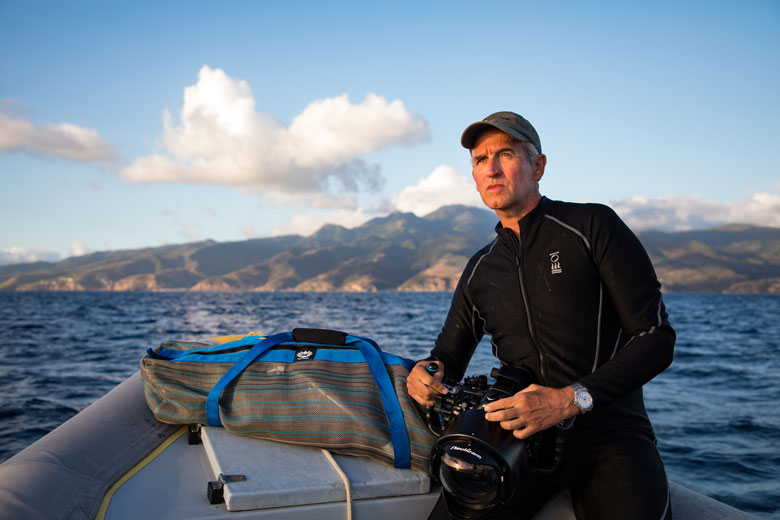Brian Skerry has traveled the globe for decades taking photos and videos of ocean ecosystems off all seven continents. His latest project took him to the waters of his own backyard—the Gulf of Maine—where as a child he discovered his love for the sea.
The result is a three-part series that has aired over the past month on Nova, a popular primetime science television program on PBS. The series, “Sea Change: The Gulf of Maine,” examines the history, science, culture, and stories of the people who live and work on the body of water that is warming faster than 97% of the world’s oceans.
Skerry’s corresponding story and photos of the changing Gulf of Maine were the cover story in the June issue of National Geographic.
Skerry, who lives in York, first started scuba diving in the Gulf of Maine about 45 years ago as a teenager, fascinated by the diversity and abundance of marine life. But in revisiting those areas for the series, he was saddened to see much of that marine life had vanished. The changes, he said, can be summed up in one word: Drastic.
“I went back twice for a week each time for these projects, and it was like a ghost town. It was almost devoid of life.”
When Skerry got the green light for the Nova series and the National Geographic cover story, he wanted to show readers and TV audiences the beauty of the Gulf of Maine.
“I wanted to show and surprise them with all the color I used to see, the invertebrate life and the fish and all the cool things that I fell in love with from an early time,” he said in a phone interview.
But when he went to different places for filming, for the most part he found there were fewer sea anemones, fewer starfish, and simply less ocean-bottom diversity than when he first dove off Maine years ago. (Cashes Ledge, about 90 miles offshore, was a notable exception and still rich in marine diversity).
Nowhere were the changes more pronounced than off Eastport, he said, which used to be “like an aquarium” when he was young.
“I used to make night dives there and see basket stars and soft corals, anemones, and all this beautiful color, and redfish and wolffish and all this kind of stuff,” he said. “I went back twice for a week each time for these projects, and it was like a ghost town. It was almost devoid of life. There was an occasional anemone here and there, but it was nothing like I remembered.”
Skerry, 62, regularly visited beaches in Maine, New Hampshire, and Massachusetts with his family while growing up in Massachusetts. He realized as a teenager he wanted to be an ocean explorer—with a camera in hand.
He got his start on a charter boat out of Rhode Island, diving on and photographing shipwrecks off New England, including German U-boats and the famous 700-foot Andrea Doria oceanliner that sank off Nantucket in 1956.
He turned his passion for the ocean, along with his diving and photography skills, into a long career as an accomplished marine photographer with still and video cameras.
Since 1998, his photos have been featured in 33 stories in National Geographic, including seven cover stories. His documentary film credits include Secrets of the Whales (produced by Academy Award-winning filmmaker James Cameron) and Return of the White Shark.
His work has taken him to the far corners of the Earth, in tropical coral reef environments, in temperate waters like the Gulf of Maine, in polar regions from the high Arctic to Antarctica, in open ocean pelagic zones, in deep oceans using submersibles and ROVs, and in mangroves.
He once spent a week on the ocean bottom in what’s known as a “saturation facility.”
Skerry, who moved to York seven years ago, pitched his idea for a series on the Gulf of Maine in 2019 to public TV station WGBH in Boston, which produces Nova. It was important, he said, to tell the story of how the 36,000-acre Gulf
has changed over time, primarily due to overfishing and climate change.
This summer, the series premiered in late July and early August. The episodes are titled “Bounty,” “Peril,” and “Survival.”
Besides coming up with the series concept, Skerry served as a producer and an underwater director. With underwater photographers shooting video for the series, Skerry gave them directions with hand signals on specific things that should be focused on.
Even though he’s dispirited and troubled by the changes in the Gulf of Maine, and less optimistic about the future than he was five years ago, Skerry still retains hopes that things can turn around. Where he finds optimism is in the people of the Gulf of Maine—fishermen, scientists, aquaculturists, and others—who recognize the threats at hand and are searching for answers.
“I guess where I find hope is that everyone knows things are changing and we need to implement solutions now,” he said. “I do fear it’s going quick. I think the window of opportunity to save what remains is closing.”
The Nova series is at: pbs.org/wgbh/nova/series/sea-change-the-gulf-of-maine/
National Geographic article: nationalgeographic.com/environment/article/gulf-of-maine-
climate-change-photographer





